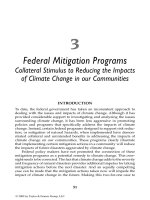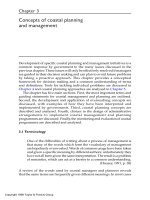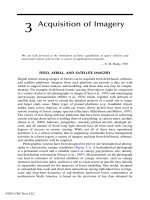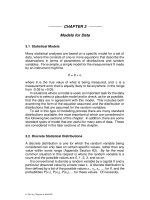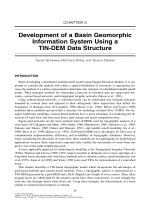Strategic management chapter 3 competitive advantage
Bạn đang xem bản rút gọn của tài liệu. Xem và tải ngay bản đầy đủ của tài liệu tại đây (349.62 KB, 23 trang )
Competitive Advantage
• Firms achieve strategic competitiveness and
earn above-average returns when their core
competencies are effectively:
– Acquired.
– Bundled.
– Leveraged.
• Over time, the benefits of any value-creating
strategy can be duplicated by competitors.
Competitive Advantage (cont’d)
• Sustainability of a competitive advantage
is a function of:
– The rate of core competence obsolescence
because of environmental changes.
– The availability of substitutes for the core
competence.
– The imitability of the core competence
Analyzing the External Environment
Opportunities
and threats
By studying the external environment, firms
identify what they might choose to do.
Analyzing the Internal Organization
Unique resources,
capabilities, and
competencies
(required for sustainable
competitive advantage)
By studying the internal environment,
firms identify what they can do
Figure 3.1
Components of an Internal Analysis
Creating Value
• By exploiting their core competencies or
competitive advantages, firms create value.
• Value is measured by:
– Product performance characteristics
– Product attributes for which customers will pay
• Firms create value by innovatively bundling and
leveraging their resources and capabilities.
• Superior value Above-average returns
Creating Competitive Advantage
• Core competencies, in combination with productmarket positions, are the firm’s most important
sources of competitive advantage.
• Core competencies of a firm, in addition to its
analysis of its general, industry, and competitor
environments, should drive its selection of
strategies.
Figure 3.2
Conditions Affecting Managerial Decisions about Resources,
Capabilities, and Core Competencies
Resources, Capabilities
and Core Competencies
Competitive
Advantage
Core
Competencies
Capabilities
Resources
• Tangible
• Intangible
Resources
Are the source of a firm’s capabilities.
Are broad in scope.
Cover a spectrum of individual, social
and organizational phenomena.
Alone, do not yield a competitive
advantage.
Resources
• Resources
– Are a firm’s assets,
including people and the
value of its brand name that
represent inputs into a firm’s
production process:
• Capital equipment
• Skills of employees
• Brand names
• Financial resources
• Talented managers
• Types of Resources
– Tangible resources
• Financial resources
• Physical resources
• Technological resources
• Organizational resources
– Intangible resources
• Human resources
• Innovation resources
• Reputation resources
Table 3.1 Tangible Resources
Financial
Resources
• The firm’s borrowing capacity
• The firm’s ability to generate internal funds
Organizational
Resources
• The firm’s formal reporting structure
Physical
Resources
• The sophistication and location of a firm’s
plant and equipment and the attractiveness of
its location
• Distribution facilities
• Product inventory
Technological
Resources
• Availability of technology-related resources
such as copyrights, patents, trademarks, and
trade secrets
Table 3.2 Intangible Resources
Human
Resources
•
•
•
•
Innovation
Resources
• Ideas
• Scientific capabilities
• Capacity to innovate
Reputational
Resources
• Brand name
• Perceptions of product quality, durability, and
reliability
• Positive reputation with stakeholders such as
suppliers and customers
Knowledge
Trust
Skills
Abilities to collaborate with others
Resources, Capabilities
and Core Competencies
Capabilities
Competitive
Advantage
Represent the capacity to deploy
resources that have been purposely
integrated to achieve a desired end
state
Core
Competencies
Emerge over time through complex
interactions among tangible and
intangible resources
Capabilities
Resources
• Tangible
• Intangible
Often are based on developing,
carrying and exchanging information
and knowledge through the firm’s
human capital
Resources, Capabilities
and Core Competencies
Competitive
Advantage
Core
Competencies
Capabilities
Resources
• Tangible
• Intangible
Capabilities (cont’d)
The foundation of many capabilities lies
in:
The unique skills and knowledge of
a firm’s employees
The functional expertise of those
employees
Capabilities are often developed in
specific functional areas or as part of a
functional area.
Table 3.3
Examples of Firms’ Capabilities
Resources, Capabilities
and Core Competencies
Competitive
Advantage
The four criteria for determining strategic
capabilities:
Value
Rarity
Core
Competencies
Capabilities
Resources
• Tangible
• Intangible
Costly-to-imitate
Nonsubstitutability
Resources, Capabilities
and Core Competencies
Core Competencies
Competitive
Advantage
Resources and capabilities that are the sources
of a firm’s competitive advantage:
Distinguish a firm competitively
and reflect its personality.
Core
Competencies
Capabilities
Resources
• Tangible
• Intangible
Emerge over time through an
organizational process of
accumulating and learning how
to deploy different resources
and capabilities.
Resources, Capabilities
and Core Competencies
Core Competencies
Competitive
Advantage
Core
Competencies
Capabilities
Resources
• Tangible
• Intangible
Activities that a firm performs especially well
compared to competitors.
Activities through which the firm adds unique
value to its goods or services over a long
period of time.
Building Core Competencies
Sustainable
Competitive
Advantage
The Four Criteria of Sustainable
Competitive Advantage
Valuable capabilities
Rare capabilities
Four Criteria of
Sustainable
Advantages
•
•
•
•
Valuable
Rare
Costly to imitate
Nonsubstitutable
Costly to imitate
Nonsubstituable
Table 3.4 The Four Criteria of Sustainable Advantage
Valuable
Capabilities
• Help a firm neutralize threats or exploit
opportunities
Rare
Capabilities
• Are not possessed by many others
Costly-to-Imitate
Capabilities
• Historical: A unique and a valuable organizational
culture or brand name
• Ambiguous cause: The causes and uses of a
competence are unclear
• Social complexity: Interpersonal relationships,
trust, and friendship among managers, suppliers,
and customers
Nonsubstitutable
Capabilities
• No strategic equivalent
Building Sustainable Competitive
Advantage
Sustainable
Competitive
Advantage
Four Criteria of
Sustainable
Advantages
•
•
•
•
Valuable
Rare
Costly to imitate
Nonsubstitutable
Valuable capabilities
Help a firm neutralize threats or
exploit opportunities.
Rare capabilities
Are not possessed by many others.
Building Sustainable Competitive
Advantage
Sustainable
Competitive
Advantage
Four Criteria of
Sustainable
Advantages
Costly-to-Imitate Capabilities
Historical
A unique and a valuable
organizational culture or brand
name
Ambiguous cause
The causes and uses of a
competence are unclear
Social complexity
•
•
•
•
Valuable
Rare
Costly to Imitate
Nonsubstitutable
Interpersonal relationships, trust,
and friendship among managers,
suppliers, and customers
Building Sustainable Competitive
Advantage
Sustainable
Competitive
Advantage
Nonsubstitutable Capabilities
No strategic equivalent
Firm-specific knowledge
Organizational culture
Four Criteria of
Sustainable
Advantages
•
•
•
•
Valuable
Rare
Costly to imitate
Nonsubstitutable
Superior execution of the chosen
business model

